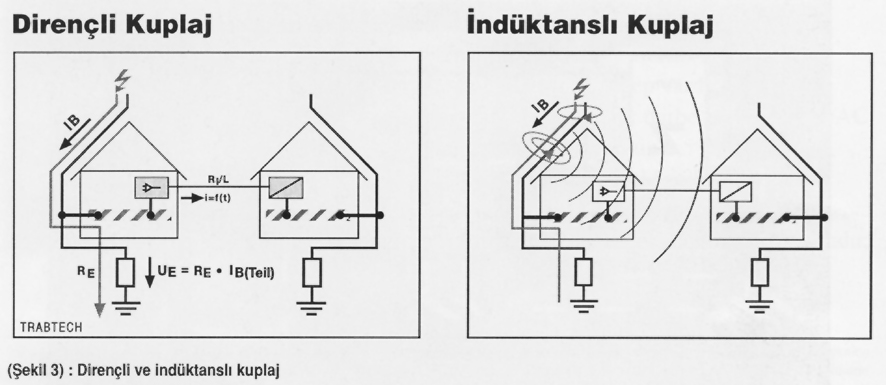Lightning is mostly known for the direct damage it causes as a naturally occurring event that generally leads to physical damage and fire. However, there are many reasons to take precautions against the indirect damages of lightning in electrical applications. An impulse voltage that can reach up to a level of 500V is about 2.5 times that of a 230VAC nominal operating voltage. Therefore, it is inevitable that impulse voltages able to reach up to 100 times the nominal voltage of a device will be destructive. Indeed, lightning discharges causing instantaneous overvoltages in energy, phone and data communication lines have been observed to grow up to 530,000 amperes of current. 200,000 amperes is the recognized upper limit within this scope, and these discharges generally occur between 2,000 and 200,000 amperes.
a) Direct Effect of Lightning (Galvanic Coupling)
When a lightning impact falls on an external lightning conductor (lightning rod, Faraday) system on a building or any carrier metal point (dish, antenna, etc.) on the roof, it moves to the indoor installation through the available grounding system as a result of the voltage increase that occurs in the grounding impedance, and pumps high partial lightning currents to the connected devices. Lightning can also directly strike on energy lines (low voltage overhead lines) and data lines, which causes the high partial lightning currents to be transferred into the building.
b) Indirect Effects of Lightning
The secondary effect of lightning currents causes instantaneous overvoltages in two ways; resistance coupling and inductive coupling.
i) Resistance coupling
Resistance coupling occurs when lightning strikes on buildings or a group of buildings that have an electrical connection between each other. The two buildings seen in the figure have a single grounding system. The grounding system of the building close to the location of the lightning strike is under the effect of potential tent (voltage gradient) created by the lightning. However, the grounding system of the next building with which it has an electrical connection, is reference ground as compared to the potential tent. Therefore, circulating currents flow through the electrical connections between them, and overvoltages occur on the devices.
ii) Inductive coupling
Inductive coupling can be defined as the transforming effect between lightning currents and lines. A lightning current with a very large value creates a magnetic field, and this magnetic field induces voltages in nearby lines (Figure 3).
